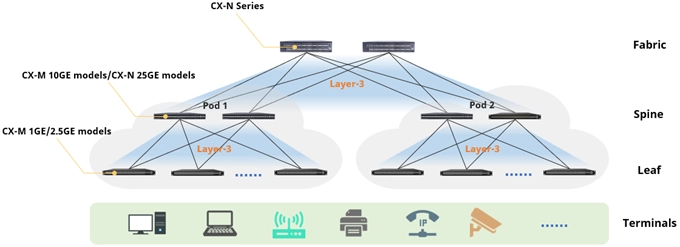Read more
How to Choose Layer-3 /Core Switches for Enterprise Networks?
When choosing a switch for an enterprise network, the network connectivity capabilities required for the same layer of equipment generally have the following principles:
- Core layer: ultra-high performance, bi-directional high-speed interfaces, high-density interfaces
- Aggregation layer: aggregation performance, high-speed uplink interfaces, medium-speed downlink interfaces
- Access layer: access performance, medium-speed uplink interface, low-speed downlink interface
Chassis-based L2/3 Switches vs. Fixed Switches
Chassis-based switches offer fault tolerance, scalability and higher performance. They are suitable for nodes in networks that require a large number of end interfaces, high bandwidth, high availability, flexibility and scalability. However, they are also more expensive than fixed switches.
In order to guarantee the availability of the network, it is common to choose medium/large scale chassis-based switches for the core and aggregation layers.
However, the chassis switch is costly to purchase and requires pre-planned network size. The small scale wastes high-performance switch resources; and when the network scale continues to expand, the unaffordable expansion price puts the user in a dilemma.
Chassis-based L2/3 Switches vs. Stackable Switches
Stackable switches are individual switches connected by cables and transceivers. While a chassis switch is one switch with various line cards and modules. It has its own system and even a firewall. A stackable switch has its common backplane, power supply modules, common processing modules and etc. The chassis switch normally tends to be more expensive than a stacked switch since it contains line cards and lots of modules, such as power supplies, fan trays and blades that go into it.
As the wired, wireless and IoT devices are growing fast, traditional stack architectures are facing several drawbacks to the next-generation enterprise network, such as:
- Inherent limitations
- Limited bandwidth
- Stack split
- Software impact
- Physical topology limitation
Read more about switch stacking: Alternatives to Switch Stacking in Enterprise Networks:Asterfusion Cloud Cluster
A Solution for Enterprise Networks without Chassis-based Switches or Stacking systems
Compared with the traditional “access-aggregation-core” network architecture, the Leaf/Spine architecture is flatter and easier to scale horizontally, while shortening the east-west communication path and reducing communication latency. With this architecture, we can use single-chip box switches to build a more efficient and streamlined next-generation enterprise network.

Under the Leaf/Spine network architecture, each node is a layer3-enabled switch, building up an IP-based layer3 network, which we call IP Fabric.
IP is a protocol that has been designed with loop avoidance, multi-path forwarding, high reliability and multi-path in mind, eliminating the need to introduce anti-loop mechanisms such as STP – combined with BGP routing and ECMP load balancing design, all physical lines in the campus network can theoretically be fully utilized, achieving 100% The network can achieve 100% bandwidth utilization and port utilization.
Based on the natural high reliability and multi-path capability of the layer3 network, we can use a more reliable and easier to manage “cloud-based cluster” solution instead of a stacked group solution.
For more information, visit: https://asterfusion.com/enterprise_network/ or send email to sales@asterfusion.com
